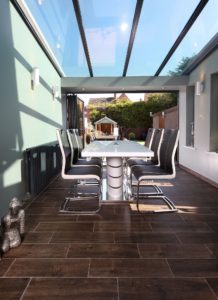Planning permission questions answered by home improvement experts
Homeowners thinking about making home improvements whilst stuck indoors can consider a range of enhancements to improve and maximise available space, including conservatories, orangeries, and solid roof extensions.
With many factors to take into account, one of the main hurdles to consider is being granted planning permission before starting any home modifications. To help inform this decision, the experts from home improvements company, Stormclad, have compiled this handy guide to planning permission, answering frequently asked questions.
John Evans, managing director at Stormclad, said:
“Being confined to your abode can really make you think about the existing space you have with your property and what you can do to transform it. In most cases you will not need planning permission for a standard single storey extension as it is considered ‘permitted development’, and therefore exempt from planning permission.
“When considering a home improvement, it’s important to know some key planning permission and building regulation guidelines.”
- What size is it allowed to be?
The most up to date regulations state that a single-story extension generally won’t require planning permission as long as it doesn’t exceed a certain size. The conservatory or extension cannot take up more than half of the area around the ‘original house’ – which is the house as it was first built, or as it stood on the 1st July 1948, if it was built before that date.
The maximum height limit is four metres for a single storey extension, but the length depends on the property:
- If the house is detached, the conservatory is restricted to a four-metre projection
- If the house is semi-detached or terraced, the projection limit is three metres
- What if my property is in a conservation area?
These conditions vary slightly, if a building is on ‘designated land’ which includes national parks and areas of outstanding natural beauty, it will most likely need planning permission. Each planning application considers an area’s unique, special character and whether the redevelopment proposals will preserve or enhance the character or appearance of that conservation area.
- What about building regulations?
Different to planning permission, building regulations ensure that buildings are designed and constructed so that they are safe, energy efficient and accessible.
New conservatories must adhere to the below rules:
- The conservatory must be built at ground level and must be smaller than 30metre2
- It must be separated from the main house by substantial walls, doors and windows, and have its own separate heating system.
- Building regulation approval is required if fixed electricity points or a toilet or sink are going to be installed.
- If your new conservatory spans the whole width of the property or home, it must be ensured that it won’t restrict ladder access to any upstairs windows so that a fire escape route is maintained.
- Most reliable home improvement companies will have extensive knowledge of building regulations, so will ensure a conservatory is designed to fit the criteria.
- How do I apply?
The first point of contact is your local council’s planning department, which can be easily accessed online. A pre-submission form will need to be filled out detailing what the project entails. From this, you will then be able to get an idea about what permissions are required. The next step is to complete an application form along with drawings demonstrating exactly what is being built. At this point, you will be required to pay a fee to cover the administrative costs. The size of this fee will depend largely on the scale of the project and where it is being completed.
For further advice about planning permission and home improvements, get in touch with the team at Stormclad.
Kindly shared by Stormclad




















